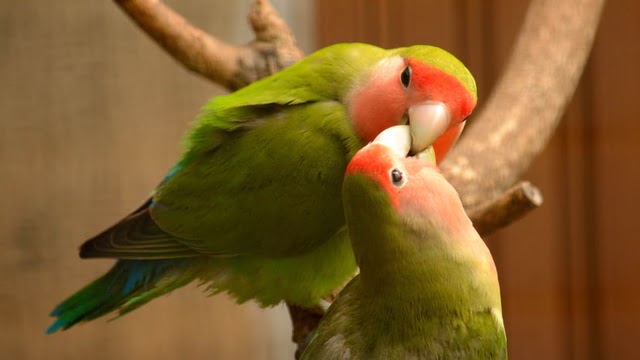Quck answer
Lovebirds are small, colorful and social birds that are often kept as pets. Here are 7 lovely facts about them:
1. Lovebirds are known for their strong pair bonds and often mate for life.
2. They are social birds and enjoy the company of other lovebirds.
3. Lovebirds are very active and playful, often entertaining their owners with their antics.
4. They are intelligent birds and can be trained to do tricks and even mimic human speech.
5. Lovebirds are native to Africa and Madagascar and there are nine different species.
6. They are named “lovebirds” because of their strong bond with their mates and their tendency to sit close together.
7. Lovebirds are popular pets because of their small size, colorful plumage and affectionate nature.
Pets

Lovebirds are adorable little parrots that are known for their affectionate nature and their ability to live happily in pairs or on their own. Despite the common belief that they become depressed when alone, lovebirds can survive well on their own. Here are some more fascinating facts about lovebirds that every bird lover should know.
1. Lovebirds Are Ideal for Beginner Bird Owners
While budgies are popular as pets, lovebirds are perfect for beginner or intermediate bird owners who can dedicate enough time and attention to them. Lovebirds are sociable, intelligent, and affectionate, making them an excellent choice for those seeking a pet bird. According to bird hobbyist Julia Scavicchio, lovebirds are more like dogs than small pets like hamsters.
The key to building a strong relationship with your lovebird is to shower them with affection from an early age. Young lovebirds thrive on daily interaction with their owners. Start with gentle movements and soft speech and progress to hand-taming by offering treats and substituting your finger for a dowel.
2. There Are Nine Lovebird Subspecies
Contrary to common belief, lovebirds are not a singular group but rather nine different subspecies. Only three of the subspecies are suitable as pets due to their charming temperaments: Fischer’s lovebird, peach-faced lovebird, and black-masked lovebird. All lovebirds, except the one native to Madagascar, originated in Africa and are diminutive in size, ranging from 5 to 6.5 inches.
According to Scavicchio, lovebirds may be small, but they require a lot of mental stimulation.
3. Lovebirds Are Active Birds
Lovebirds rise with the sun and become active throughout the day, settling down by mid-morning and resuming their noise-making by late afternoon. They should be let out of their cages at least once a day to explore their environment and need a variety of toys for stimulation.
Lovebirds enjoy exploring different textures and playing with toys, according to Scavicchio. Ideal toys include dye-free paper, noisy toys, long straight perches, and ropes. It is a common myth that lovebirds need a partner, but they can thrive on their own with proper care and attention. A single lovebird requires more attention but can be easier to train. In contrast, a pair of lovebirds may prefer their own company and become less interested in human interaction. Lovebirds can sometimes be potty trained, and a consistent routine can help them feel at home. Lovebirds are not known for talking but rather for chattering and chirping, making various beeping and buzzing noises.

The Nyasa lovebird, similar to the black-cheeked lovebird and Abyssinian lovebird, is not a common choice for a pet. In their natural habitat, lovebirds prefer to live in small groups.
Interestingly, lovebirds are part of the Psittaciformes order, which encompasses all parrots. They possess a hooked bill and zygodactyl feet, with two toes pointing forward and two toes pointing backward.
This article was initially published on August 27, 2019.
FAQ
1. What is a lovebird?
A lovebird is a small, colorful parrot species that is native to Africa. They are known for their affectionate behavior towards their mates, hence the name “lovebird”. These birds are popular pets due to their playful and sociable nature, as well as their striking appearance with vibrant feathers and a distinctive beak.
2. How long do lovebirds live?
The average lifespan of a lovebird is around 10 to 15 years in captivity, although some have been known to live up to 20 years with proper care and attention. It is important to provide a healthy and balanced diet, plenty of exercise, and regular veterinary check-ups to ensure your lovebird lives a long and happy life.
3. How do lovebirds communicate?
Lovebirds are known for their vocalization and use a variety of sounds to communicate. They make chirping, whistling, and tweeting noises to express a range of emotions, including happiness, excitement, and alarm. Lovebirds also communicate through body language, such as fluffing their feathers, bowing their head, and wagging their tail feathers.
4. Are lovebirds monogamous?
Yes, lovebirds are monogamous and form strong bonds with their mate. They are known for their affectionate behavior towards each other, such as preening each other’s feathers, sitting close together, and sharing food. Lovebirds will often stay together for life and may become depressed or anxious if separated from their mate for too long.
5. What are the different types of lovebirds?
There are nine species of lovebirds, each with their own unique characteristics and color patterns. Some of the most popular species include the peach-faced lovebird, which has bright green feathers and a peach-colored face, and the Fischer’s lovebird, which has a striking combination of green, yellow, and orange feathers. Other species include the black-cheeked lovebird, the masked lovebird, and the Nyasa lovebird.





Leave a Reply